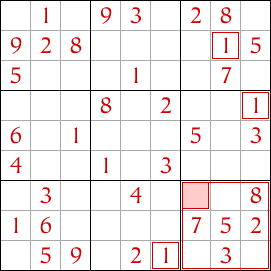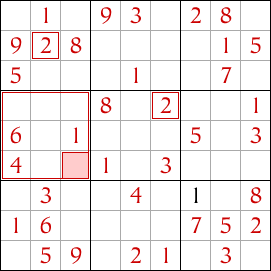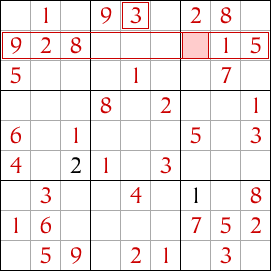Strictly Sudoku - Medium Sudoku with solving technique
The second most common technique to solve a Sudoku puzzle is the Hidden Single technique. You've now mastered the Open Single technique and you can start tackling more difficult puzzles. Before going to hard sudoku puzzles, you'll need to understand and practice this technique. Let's get into it.
Hidden Single technique
Sometimes there's only one square in a group where a particular number is allowed. Under the rules of sudoku, every row, column and block must contain each number exactly once.
Take a look at the lower-right block of nine cells in this sudoku below. One of these nine cells must contain the number 1, but which one? It can't be the empty cell in the far right column, because this column already contains a 1 and the number is not allowed to appear twice in any column, row or block. The next column in also contains a 1, so the empty cell in this column is also banned.

This leaves two empty cells in the seventh column. But the bottom row in the sudoku also already contains a number 1 so the empty cells in this row are also banned.
This leaves just one cell in the lower-right block, the highlighted cell, that is allowed to contain a 1. This is the hidden single and we can place a 1 in it.
Now look at the middle left block of three cells. Where does the number 2 go in this block? The two highlighted cells already contain a 2, banning the number from other cells in the second column and the fourth row of the sudoku. This leaves just one cell in the middle-left block where the number 2 is allowed to go, the highlighted cell, so we place a 2 in it.

So far, we've applied the hidden single to blocks, using numbers in rows and columns that intersect with the block to find where a number isn't allowed to go. We can also apply the hidden single technique to rows and columns.
Look at the second row in the sudoku. This row must contain a 3 in exactly one cell. There are four empty cells in the row but which of these are allowed to contain the number 3? Three of them are in the centre-top block of nine cells, and this block already contains the number 3 in another cell. So none of these three cells may contain a 3. That leaves just one cell in the second row where a 3 is allowed, the highlighted cell, so we place a 3 here.

This sudoku can be completed using only the hidden single technique, although sometimes they'll be hard to find and you may find it easier to use the open single technique when the hidden singles are being elusive.